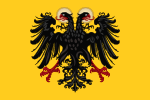神圣罗马帝国军队
| 神圣罗马帝国军队 | |
|---|---|
| 拉丁语:Exercitus Imperii | |
 | |
| 存在时期 | 1422–1806 |
| 国家或地区 | |
| 部门 | 陆军 |
| 总部 | 维也纳 |
| 参与战役 | 奥斯曼-哈布斯堡战争 北方战争 第二次北方战争 曼图亚王位继承战争 斯堪尼战争 大土耳其战争 法荷战争 九年战争 西班牙王位继承战争 四国同盟战争 波兰王位继承战争 奥地利王位继承战争 七年战争 巴伐利亚王位继承战争 法国大革命战争 拿破仑战争 |
神圣罗马帝国军队(德语:Reichsarmee,Reichsheer 或 Reichsarmatur;拉丁语:exercitus imperii)创建于1422年,并在1806年因拿破仑战争而随神圣罗马帝国本身被解散。
帝国军队并不是一支随时准备为帝国而战的常备军。当有危险时,帝国军队会组织起它的兵源,以便在帝国战争(Reichskrieg)或帝国执行任务(Reichsexekution)期间进行军事行动。它只能在帝国议会同意的情况下部署,不是皇帝私人的军队,不应与皇帝的帝国军队(Kaiserliche Armee)混淆。帝国军队的各个势力往往对地方的效忠比对皇帝的忠诚更强烈。
历史
[编辑]1422年在纽伦堡召开的帝国议会要求从帝国各地派遣军队对付胡斯派,并创建了神圣罗马帝国军队[1]。而之后在1420年至1434年的胡斯战争中神圣罗马帝国的军队也证明了自身的价值。
但此后一百年,帝国军队的数量要嘛是直接受到数量限制,要嘛就是受到经费的限制。
1521年,沃姆斯议会试图将帝国军队的数量维持在20,063名步兵和4,202名骑兵,但后来简化为20,000名步兵和4,000名骑兵。1521年,沃姆斯议会试图将帝国军队的数量维持在20,063名步兵和4,202名骑兵,但后来简化为20,000名步兵和4,000名骑兵。而维持帝国军队运行的每月分期付款款项则被称为“罗马救助”[2]。
而各领土的军事贡献分配量在《帝国登记册》中有明文规定,第一个登记册纪载于 1422 年[3]。
人们普遍认为帝国军队参与了1618年至1648年间的三十年战争,但事实并非如此;参加战争的是帝国军队(Kaiserliche Armee),为直属神圣罗马皇帝的军队。[4]。
神圣罗马帝国军队的组成最终由1681年的“帝国卫队令”(Reichsdefensionalordnung)确定,并为每个行政圈分配了军事费用。最后,确定了每次招集时的配额。军队总数(拉丁语称为Simplum)定为步兵28,000人,骑兵12,000人(其中龙骑兵2,000人),紧急情况下,在保持配额比例不变的情况下,人数可以增加一倍或三倍。[5][6]。而增加一倍或三倍的额外部队在拉丁语中被称为Duplum或Triplum[7]。
| 帝国行政圈 | 骑兵 | 歩兵 |
|---|---|---|
| 奥地利行政圈 | 2,522 | 5,507 |
| 勃艮第行政圈 | 1,321 | 2,708 |
| 莱茵选侯行政圈 | 600 | 2,707 |
| 弗兰肯行政圈 | 980 | 1,902 |
| 巴伐利亚行政圈 | 800 | 1,494 |
| 施瓦本行政圈 | 1,321 | 2,707 |
| 上莱茵行政圈 | 491 | 2,853 |
| 下莱茵-威斯特法伦行政圈 | 1,321 | 2,708 |
| 上萨克森行政圈 | 1,322 | 2,707 |
| 下萨克森行政圈 | 1,322 | 2,707 |
| 合计 | 12,000 | 28,000 |
1681 年设立的帝国行政圈的配额直到帝国灭亡(1806 年)为止基本上保持不变。在实际服役中,他们被编成团,有时提供资金以换取士兵[10]。
延伸阅读
[编辑]- Vladimir Brnardic, Darko Pavlovic, Imperial Armies of the Thirty Years' War (2009)
- John G. Gagliardo, Reich and nation: the Holy Roman Empire as idea and reality, 1763-1806 (Indiana University Press, 1980)
- Winfried Dotzauer, Die deutschen Reichskreise (1383–1806) (Stuttgart 1998, ISBN 978-3-515-07146-8)
- Max Jähns, 'Zur Geschichte der Kriegsverfassung des deutschen Reiches' in Preußische Jahrbücher 39 (1877)
- Karl Linnebach, 'Reichskriegsverfassung und Reichsarmee von 1648 bis 1806' in Karl Linnebach, Deutsche Heeresgeschichte (Hamburg 1943, 2nd ed.)
- Helmut Neuhaus, 'Das Reich im Kampf gegen Friedrich den Großen - Reichsarmee und Reichskriegführung im Siebenjährigen Krieg' in Bernhard Kröner, Europa im Zeitalter Friedrichs des Großen - Wirtschaft, Gesellschaft, Kriege (Munich, 1989), pp. 213–243
- Martin Rink, Harald Potempa, 'Der Zusammenbruch des Alten Reichs (962-1806) und des alten Preußen im Jahre 1806' in Militärgeschichte March 2006
- Hanns Weigl, Die Kriegsverfassung des alten deutschen Reiches von der Wormser Matrikel bis zur Auflösung (Bamberg, 1912)
文献
[编辑]- ^ John Rigby Hale, John Roger Loxdale Highfield, Beryl Smalley, Europe in the late Middle Ages (Northwestern University Press, 1965), p. 228.
- ^ Thomas Robisheaux, Rural Society and the Search for Order in Early Modern Germany (2002), p. 177.
- ^ John G. Gagliardo, Reich and nation: the Holy Roman Empire as idea and reality, 1763-1806 (Indiana University Press, 1980), p. 36.
- ^ Vladimir Brnardic, Darko Pavlovic, Imperial Armies of the Thirty Years' War, 1: Infantry and Artillery (2009).
- ^ William Coxe, History of the House of Austria, vol. 1, part 2 (1807), p. 1040: "Oct. 1681: This heterogeneous mixture was now avoided by assembling the troops according to vicinity of territory, and apportioning the contingents on the respective circles. By this system, arrangements were made for forming an army of 28,000 infantry and 12,000 cavalry, which could be raised to 80,000 or even 120,000 men by merely doubling or tripling the contingents."
- ^ Militärgeschichtliche Zeitschrift, vol. 62 (Militärgeschichtlichen Forschungsamt, 2003), p. 121
- ^ Corvisier & Childs (1994), p. 306: "...when more men were needed, further troops would be called up, the Duplum, Triplum, etc."
- ^ 'Pütter's Political History of Germany' in The Analytical review, or History of literature, domestic and foreign, on an enlarged plan, vol. 8 ([s.n.], 1788-1798, 1790), p. 527: "The division among the ten circles of the 40,000 men, consisting of 12,000 cavalry, including 2,000 dragoons, and 28,000 infantry, was rated in the following proportions..."
- ^ Militärgeschichte - Zeitschrift für historische Bildung (issue of March 2006), table S. 7.
- ^ Robisheaux (2002), p. 220.
